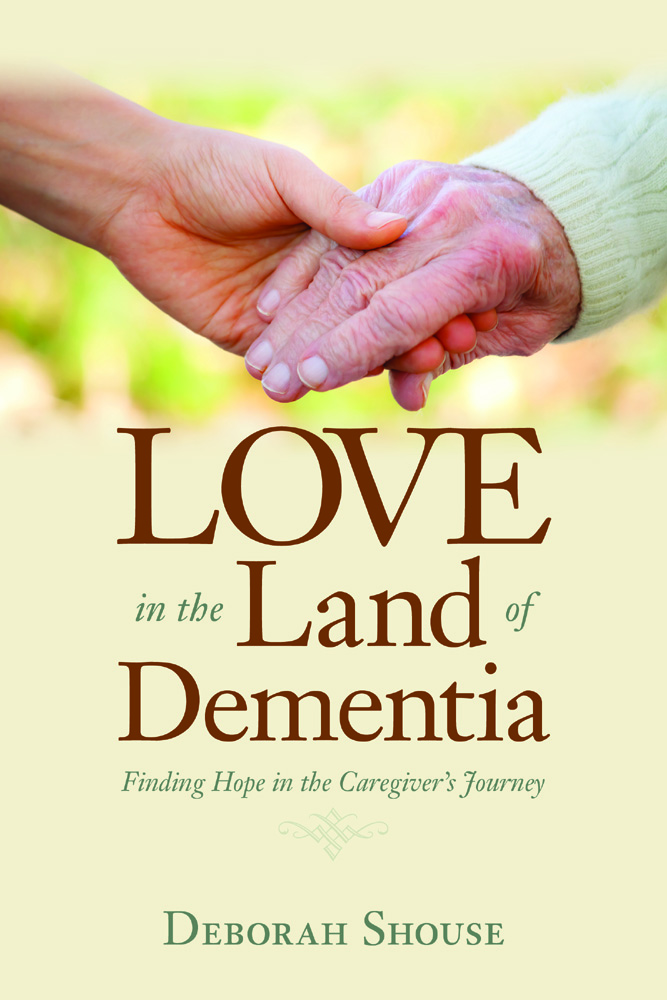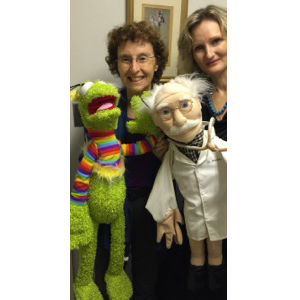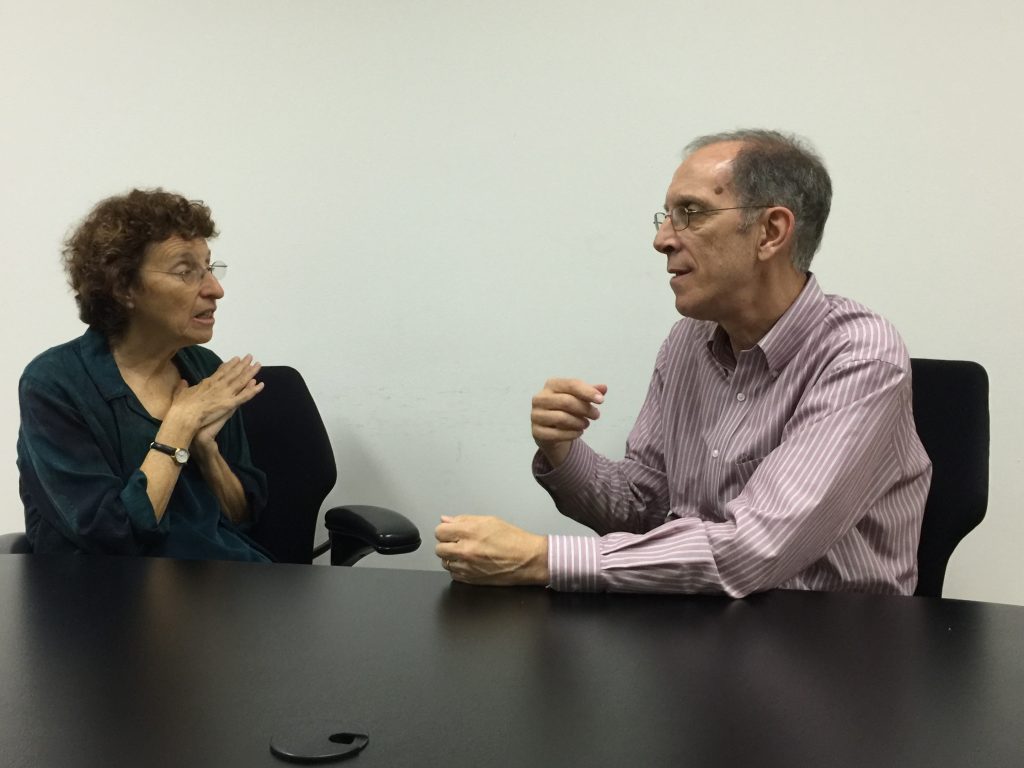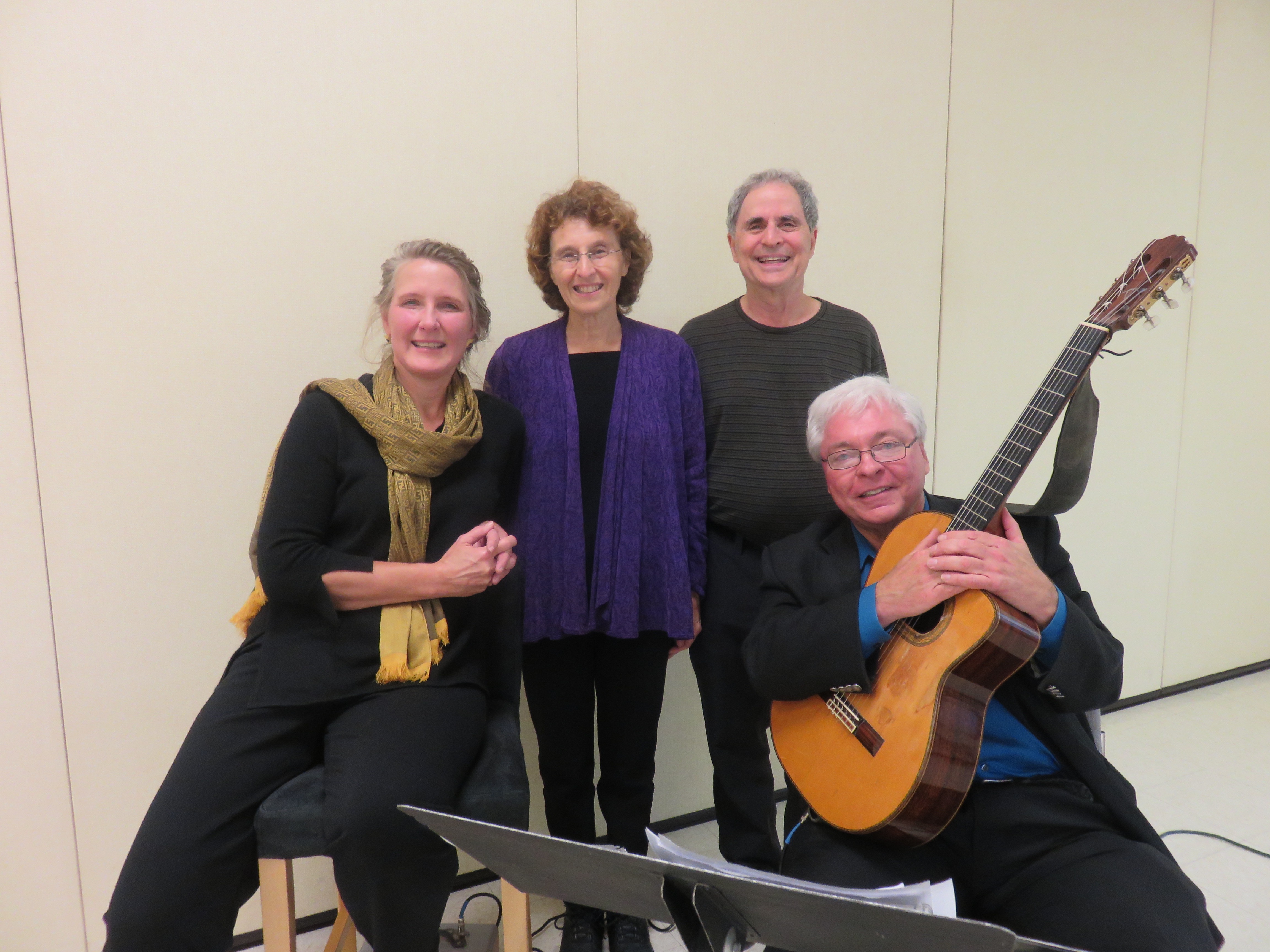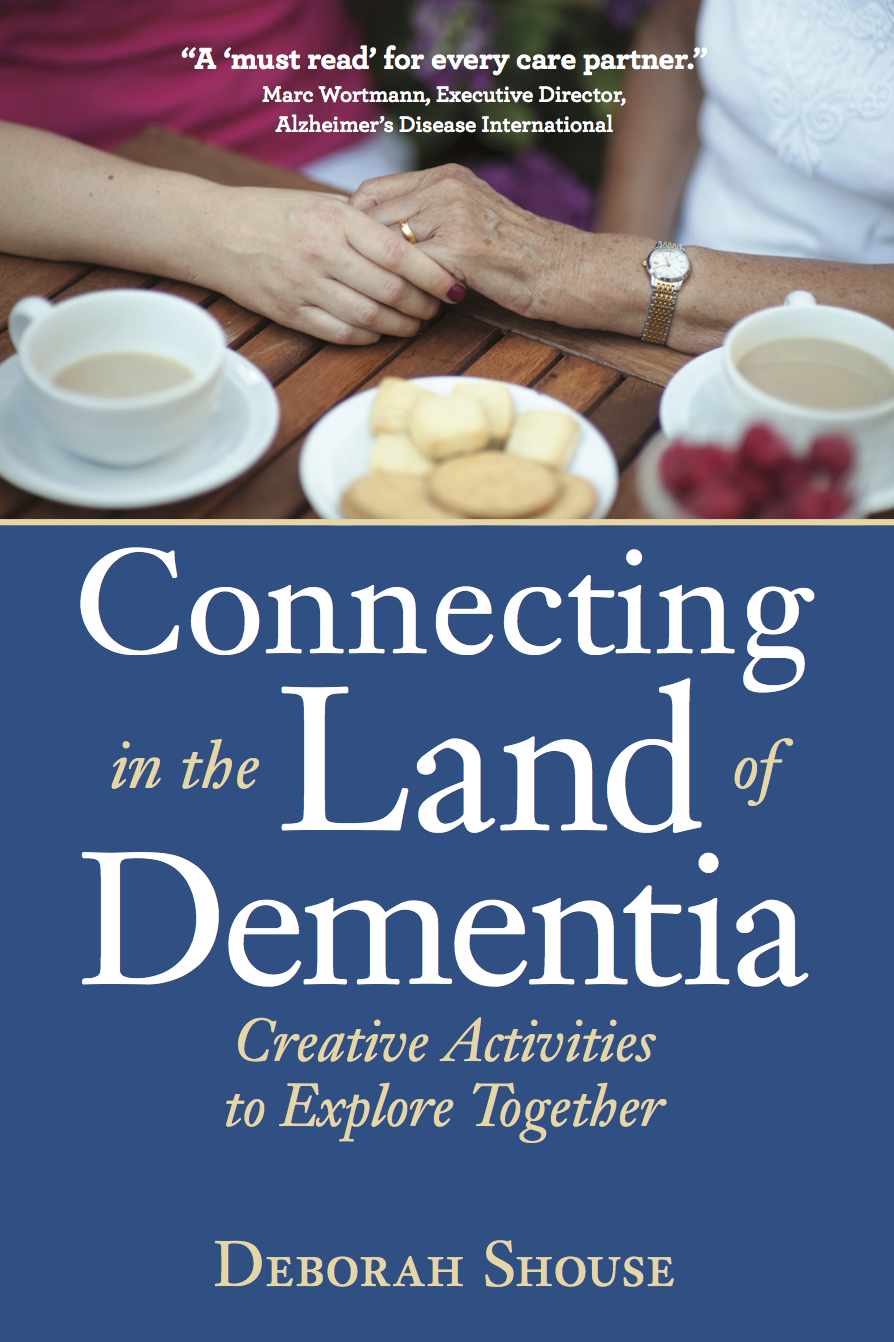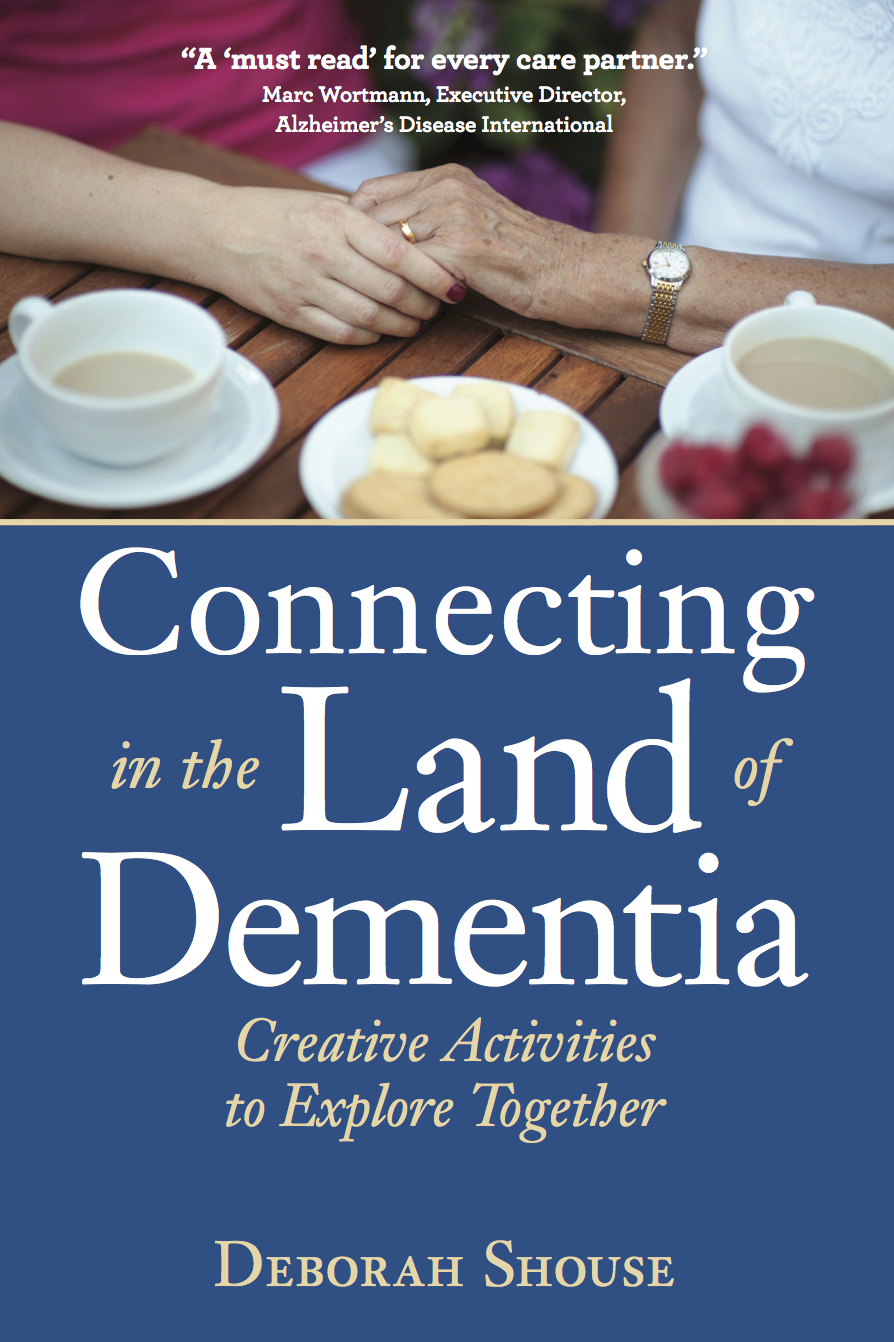The Arts
A Thanksgiving Love Story: Bringing Home the Gravy
Thanksgiving changed the year I went vegetarian. I did not mind giving up the tender, moist turkey or the savory oyster-specked stuffing. But giving up the flavorful flow of mushroom-laden gravy was quite another thing. I watched enviously as my family ladled the luscious liquids over their mashed potatoes, turkey and stuffing. As I nibbled dryly on my carrots, green beans and salad, my lower lip protruded. I felt left out and deprived.
My brother, Dan, ever alert to the pouting big sister, came up with a solution.
“Next year I will make special vegetarian gravy just for you,” Dan promised.
Years later, that special vegetarian gravy has become one of my favorite Thanksgiving rituals. I begin fantasizing about it the moment the autumn leaves turn crimson. I know that in mere weeks, my brother and his family will arrive and I will have my yearly boost of family and feasting, highlighted by gravy.
When my brother calls to tell me his travel plans, I write his arrival time and GRAVY on my calendar. The night he comes to town, we make the shopping list together, avidly discussing how many pounds of mushrooms we need for both the carnivore and vegetarian pots of gravy. I relish the early-Wednesday morning trip through the grocery store, where Dan and I and our children carefully select the foods we will be making the next day. We linger in the produce aisle, filling several sacks with gleaming white mushrooms and buying rustling yellow onions.
On Thanksgiving Day, Dan and I and other family members spend long, luxurious hours cooking. Dan mans the stove and I manage the slicing and chopping. Together we snap, peal, slice and dice the vegetables that will accessorize the turkey. I take special pleasure in wiping clean and slicing the mushrooms, then bringing my brother the brimming bowlful. When he has nodded his approval, I get out the old copper pot I bought in Germany in the early seventies. This year, Dan is improving his already amazing gravy. With his new immersion blender, he creates a rich base of caramelized onions, whose flavor surpasses that of the lowly vegetable cube. He adds in a little flour, then gentles the mushrooms into the onion broth. When the pot is bubbling with thickening nectar, he says, “Taste this and see what you think.”
I always think the same thing—“Wow, this is great.”
We are in a state of giddy and satisfied exhaustion by the time our guests arrive. We share grateful prayers with everyone and lay out the feast, including plenty of turkey-based gravy for the rest of the family.
Then comes the moment I have been waiting for: I sit down, my own personal pot of gravy poised by my plate. I cover the mashed potatoes, carrots, green beans, and salad with the aromatic concoction and I savor every bite. But more importantly, I savor the bounty, creativity, and love that have gone into this simple dish. Through this gravy, my brother speaks with his hands and his heart, saying: “I care about you and I am going to make sure you are not left out and that you have something fantastic to eat.”
For that and so much more, I am thankful.
…………
And now, if you’d like to create a Thanksgiving love story, bring home this delicious gravy.
Dan Barnett’s Chicago Style Never-Enough-Mushroom Vegetarian Gravy
Ingredients
2 large onions (chopped)
2 pounds (or more) white button mushrooms sliced (can add some portabellas for enhanced flavor)
1 cup of white wine (of lesser quality)
Salt & pepper to taste
Olive oil
Directions
To create the gravy base:
In a four -quart pot, pour a thin layer of olive oil and turn the burner on medium.
Add the onions and sauté for10-15 minutes until they are caramelized (golden brown)
Add water until the pot is about half full.
Simmer slowly for 30 minutes.
Blend the onion water mixture using either an immersion blender or by transferring the mixture to a food processor.
Once you have the gravy base
Add the 2 pounds (or more) of sliced mushrooms, white wine and fill the pot with water until it is 3/4 full.
Simmer for 30 minutes and season to taste with salt and pepper.
###
Deborah Shouse is the author of Connecting in the Land of Dementia: Creative Activities to Explore Together and Love in the Land of Dementia: Finding Hope in the Caregiver’s Journey.
Dementia Friendly Holidays: Three Tremendous Tips
Tryn Rose Seley is a gentle and creative force in engaging people who are living with dementia. I met her when I was searching for experts for the book and have truly enjoyed her wisdom and compassion. You’ll enjoy her ideas for having dementia friendly holidays.
Handling the Holidays with Grace, Compassion, and Fun!
Guest Post from Tryn Rose Seley
Be gentle with yourself and your expectations around holidays, which can be challenging for anyone, particularly those living with dementia. Plan with care, enjoy your family and friends, and adjust the schedule to suit a person’s energy.
Party Hearty, and Early
Have a party early in the day, when energy is best.
People living with dementia, like many of us, need to conserve energy. Never mind the midnight traditions; create a dementia friendly holiday celebrating by gathering at 10 a.m. or 2 p.m. You will all enjoy the event and get home at a reasonable hour.
Film the Fun
A person with dementia often thrives with short, simple visits. Create a quiet room for one to one visits, and film the rest of the festivities to re-play for days, months, and years to come. The happy, boisterous fun can happen in another part of the house. If you run a camera in both rooms, you have captured the joy of the party, and can selectively play back the event in smaller bursts to enjoy the fun at any time of the year. When you all need a lift, play this footage.
Write Down Your Memories
Have a journal so family and friends can write memories of this gathering, or ones from the past, to read aloud any time you need a good story. Holiday visitors may come once a year, but you can extend their presence by asking them to write thoughts, affirmations, and stories from childhood, college, or any part of life. Writing down these stories brings the past to the present, where it can be re-lived, now and in the future.
When it comes to holidays this year, consider this: notice, adjust, and explore the possibilities of truly creating a dementia friendly holiday celebration and orchestrating your gatherings in a different way. Don’t give them up; change them up. #
For more inspiring ideas, read Tryn’s book, “15 Minutes of Fame/Empowering Caregivers of Those with Alzheimer’s”
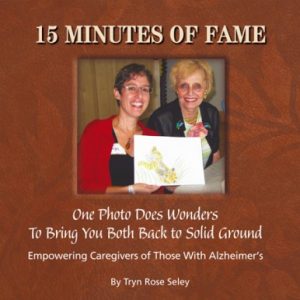 Connect with Tryn through:
Connect with Tryn through:
@trynrose
facebook.com/caregiverheart
Click here for more about the book
Deborah Shouse is the author of Connecting in the Land of Dementia: Creative Activities to Explore Together and Love in the Land of Dementia: Finding Hope in the Caregiver’s Journey.
An Inside Look at Creative Aging
We are huddled on the floor, concentrating on our assignment. Each of us has shared an important saying or proverb that impacted our lives and now we are turning those six sayings into a song. We have a daunting five minutes to accomplish this creative task. However, we also have songwriter and musician Vanessa Torres from Lifesongs to guide us. After we've shared our sayings, Vanessa instantly comes up with a theme--These Are Things That I've Learned. Our song centers around that chorus, with each of us weaving in our personal sayings.
In the other three corners of the room, groups are collaborating, turning their sayings into spoken word, dramatic movement, and theatrical improv. Our facilitator, Susan Pearlstein, Founder Emeritus for the National Center for Creative Aging in Washington, DC, and the Founder of Elders Share the Arts in New York City, calls us back to the circle and each group performs their piece. In mere minutes, we have learned something important about each person, we have created an artistic work with people we're just getting to know, and we have appreciated the power of creating something together.
This was an exhilarating beginning to the third annual NCCA conference on creative aging.
These are things I that learned at the conference:
 Every person is inherently creative. Of course, I knew this. But it is so lovely to be reminded in so many ways. It is so lovely to be invited more deeply into your own creativity through song, dance, theater games, art, movement, and brainstorming. It's inspiring to be in a room where so many are expressively at ease with their creative spirits.
Every person is inherently creative. Of course, I knew this. But it is so lovely to be reminded in so many ways. It is so lovely to be invited more deeply into your own creativity through song, dance, theater games, art, movement, and brainstorming. It's inspiring to be in a room where so many are expressively at ease with their creative spirits.
Here are some insights from conference luminaries. Some are not attributed because I was so raptly listening I didn’t write everything down!
“Creativity is a moment when we look at the ordinary, but see the extraordinary.”
“Art is for everyone. It's not a frivolous add-on. It's a vital part of life. Everyone is creative. Dream and dispel the myth that ‘I can't do art.’ Aging has been treated like it’s all gray but it's really expansive colors.” Remarks of Jane Chu, Chairman of the National Endowment for the Arts, Sept 25th, 2016. Click here to enjoy a video of the Chairman
“Feeling useful is a human right.”
“Fifty percent of our elders feel lonely.” Vice Mayor Karsten Klein, The Hague
"By listening closely to one another, we can help illuminate the true character of this nation, reminding us all just how precious each day can be and how great it is to be alive." Dave Isay, founder of StoryCorps, via Eddie Gonzalez
“Bringing what is inside to the outside; it is important to do this as we age.” Mary Luehrsen, National Association of Music Merchants
“Creativity is the connective tissue that we use to build community across diverse differences.” Anne Basting, TimeSlips, ™ Recipient of a 2016 MacArthur Genius Grant
“Instructors need people living with dementia as co-teachers to transform educational goals. “ Dr. Elizabeth Lokon, Opening Minds Through Art
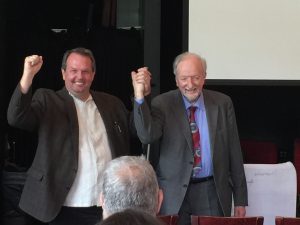
John Killick (right), poet, author and innovator in creativity and dementia, heard this wisdom one day while visiting a memory care community:
“Words of comfort are free, but very necessary.”
“I love it when you hold out your hand and water pours from it.”
“If you don't ask for the moon, you don't even get a piece of cheese.”
“You have to introduce yourself or else it all goes brittle.”
“Life is the slackness, the film and the veil.”
“Every time I look for home, I find you.”
John says, “This tells me that people with dementia are really creative and all we have to do is listen and be enriched.
This is just a soupçon of things that I learned. I wish I could have talked to every person at the conference. I wish I could have listened full on to their stories, to their sayings and proverbs, to the things that they knew and the things they had learned. Which is one reason I hope to return to the conference next year.
Deborah Shouse is the author of Connecting in the Land of Dementia: Creative Activities to Explore Together and Love in the Land of Dementia: Finding Hope in the Caregiver’s Journey.
Therapeutic Puppetry: The Best Rx is Smiles
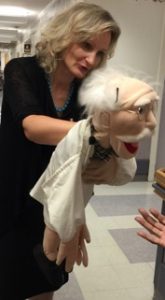 I’ve met a lot of doctors whom I admire, due to their intelligence, listening skills, willingness to collaborate, and their ability to have the occasional hearty laugh. Recently Veronica Kaninska, Certified Therapeutic Recreation Specialist, introduced me to a Doc I instantly fell in love with.
I’ve met a lot of doctors whom I admire, due to their intelligence, listening skills, willingness to collaborate, and their ability to have the occasional hearty laugh. Recently Veronica Kaninska, Certified Therapeutic Recreation Specialist, introduced me to a Doc I instantly fell in love with.
I went on rounds with Veronica and Dr. Moody, who often works with people who are living with dementia. I was so impressed with his knowledge of each individual and the warm way he offered his services. His first patient lit up when he and Veronica strolled toward her.
"How are you today?" he asked in a friendly avuncular voice. "Dr. Moody is here to check your mood. Are you feeling happy?"
"Yes, Dr. Moody, I'm happy now that you're here."
"Let me check your smile."
She smiled broadly and Dr. Moody nodded approvingly.
"Let me see your eyes."
She widened her eyes.
"Good. Your eyes are sparkling. I hope you keep your happy mood all day."
"I will Dr. Moody, I will."
We continued with Dr. Moody checking on some more patients. Each one enjoyed his company and he promised to come again and check on their moods.
After rounds, Veronica slid Dr. Moody off her arm and hung him near another popular puppet, Froggie, who she also uses for therapeutic purposes.
"People who are living with dementia often feel very comfortable communicating with puppets," Veronica says.
I wondered if Dr. Moody was open to new patients and Veronica assured me he was.
Click here to meet the good doctor. 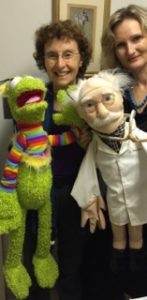
"Puppets break down barriers,” Veronica says. "They have no religion, no gender, and no judgment. People living with dementia often feel comfortable confiding in a puppet."
In a space of three to five minutes, I saw Veronica and Dr. M transform the energy of the people they visited. I asked Veronica to share a few tips for using puppets.
If you'd like to know more about Veronica and her work, read her chapter in Connecting in the Land of Dementia.
Deborah Shouse is the author of Connecting in the Land of Dementia: Creative Activities to Explore Together and Love in the Land of Dementia: Finding Hope in the Caregiver’s Journey.
Shall We Dance?
 Normally, I do not like being the center of attention. But when Sebastian Tomkowski asked me to dance the merengue, I said yes. Actually, my first reply was, "I can't dance." But Sebastian assured me he would guide me, literally, every step of the way.
Normally, I do not like being the center of attention. But when Sebastian Tomkowski asked me to dance the merengue, I said yes. Actually, my first reply was, "I can't dance." But Sebastian assured me he would guide me, literally, every step of the way.
Sebastian is one of the dancers working with Rhythm Breaks Cares (RBC), a non-profit that specializes in bringing the energy and joy of ballroom dance to people who are living with dementia. We were lucky to experience one of RBC's sessions in a New York City care facility.
When everyone was gathered in a circle, Stine Moen, one of RBC's founders, put on some Frank Sinatra tunes. Instantly, one woman danced her way into the room. Her movements were graceful and stylish. When Sebastian invited her to waltz, she readily accepted.
Stine asked a seated women if she'd like to dance. The woman said, "I have this walker and I can't dance with it."
"You can," Stine assured her. "You can use your walker and you and I can dance together."
The woman demurred and sat swaying to the music. But when Stand by Me started playing, she hoisted herself to her feet, grabbed the walker, and began moving rhythmically around the room.
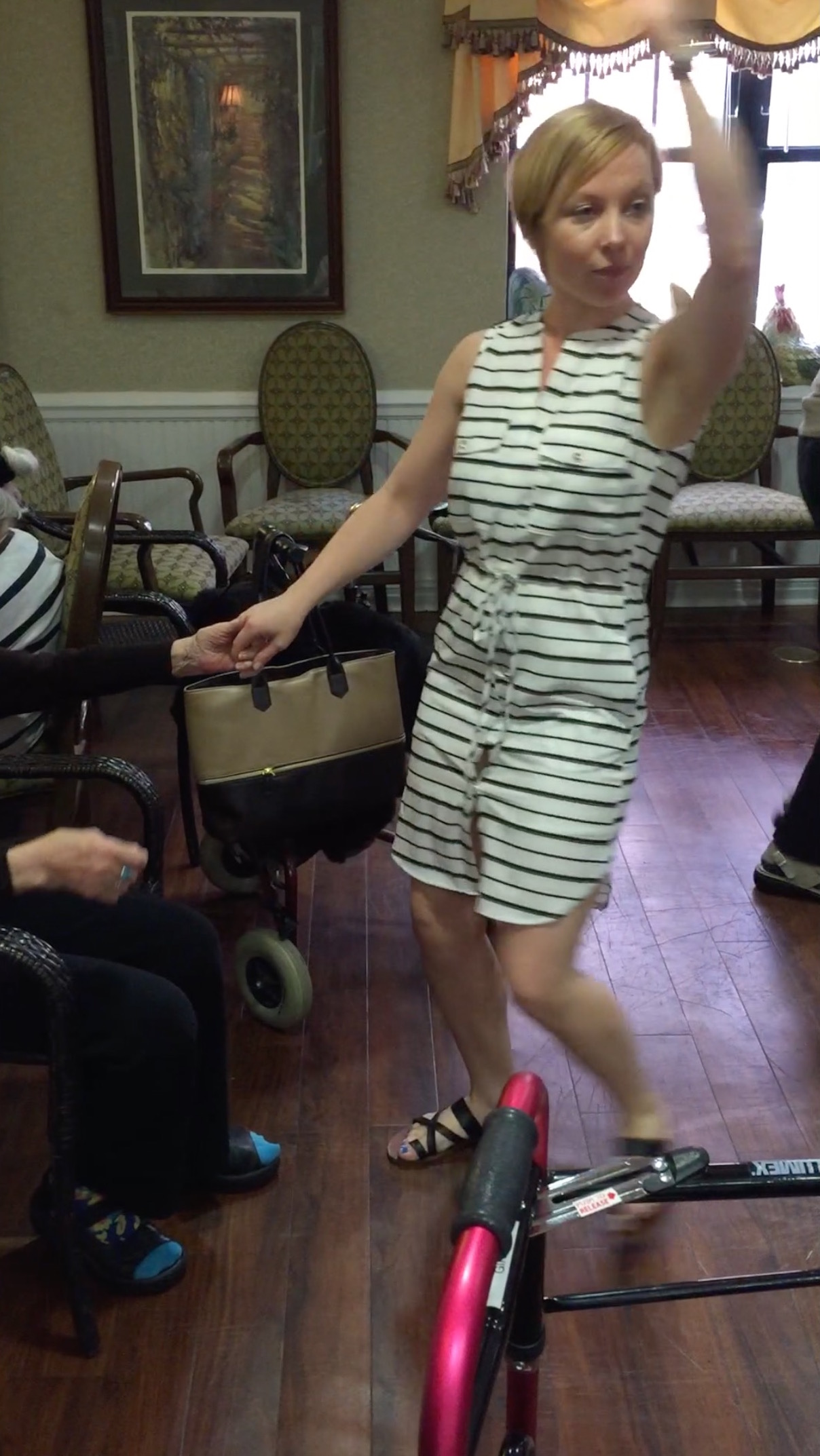 Two men sat in the circle, seemingly not registering the music. When Stine asked if they'd like to dance, one man held out his hand. Stine took his hand and let him guide the movements, while she made fancy arm gestures that looked as though they were waltzing in an elegant ballroom.Click here for dancing ideas.
Two men sat in the circle, seemingly not registering the music. When Stine asked if they'd like to dance, one man held out his hand. Stine took his hand and let him guide the movements, while she made fancy arm gestures that looked as though they were waltzing in an elegant ballroom.Click here for dancing ideas.
One woman sat stock still, but sang along when the song "Fever" played.
"I used to be a singer and my husband played the piano," she told me, when I sat beside her. "But I don't remember the words." She then proceeded to croon along with "I've Got You Under My Skin."
The energy from the music and movement seemed to engage everyone. Even a man who seemed immobile, his mouth tight, his hands clenched up near his face, gradually softened his expression and lowered his hands to his lap.As for me, I reveled in the experience, dancing with the residents or smiling and moving our hands in time to the music. And of course, I loved my once-in-a-lifetime merengue experience.
I asked Stine to offer a few tips for care partners who wanted more movement in their lives.
Here are her suggestions.
"We always start with the music." says Stine. "That sets the tone."
Once the music is playing, if possible, make eye contact. Then smile and hold out a hand. Move in ways appropriate to your partner’s abilities.
Celebrate every movement. Even swaying your arms together to the music is a form of dance.
“It's not about getting the steps right,” Stine says. “It's about connecting through music and movement.”
Want to learn more about the power of dance? Visit the RBC website. Good news—RBC offers training for qualified dancers, so they can bring this exciting program to their own communities.
Click here for additional tips from Stine.
Click here for tips from Sebastian.
Read more about creative programs in Connecting in the Land of Dementia: Creative Activities to Explore Together. Order your copy from your favorite independent or online bookstore.
Deborah Shouse is the author of Connecting in the Land of Dementia: Creative Activities to Explore Together and Love in the Land of Dementia: Finding Hope in the Caregiver’s Journey.

The Power of the Playlist
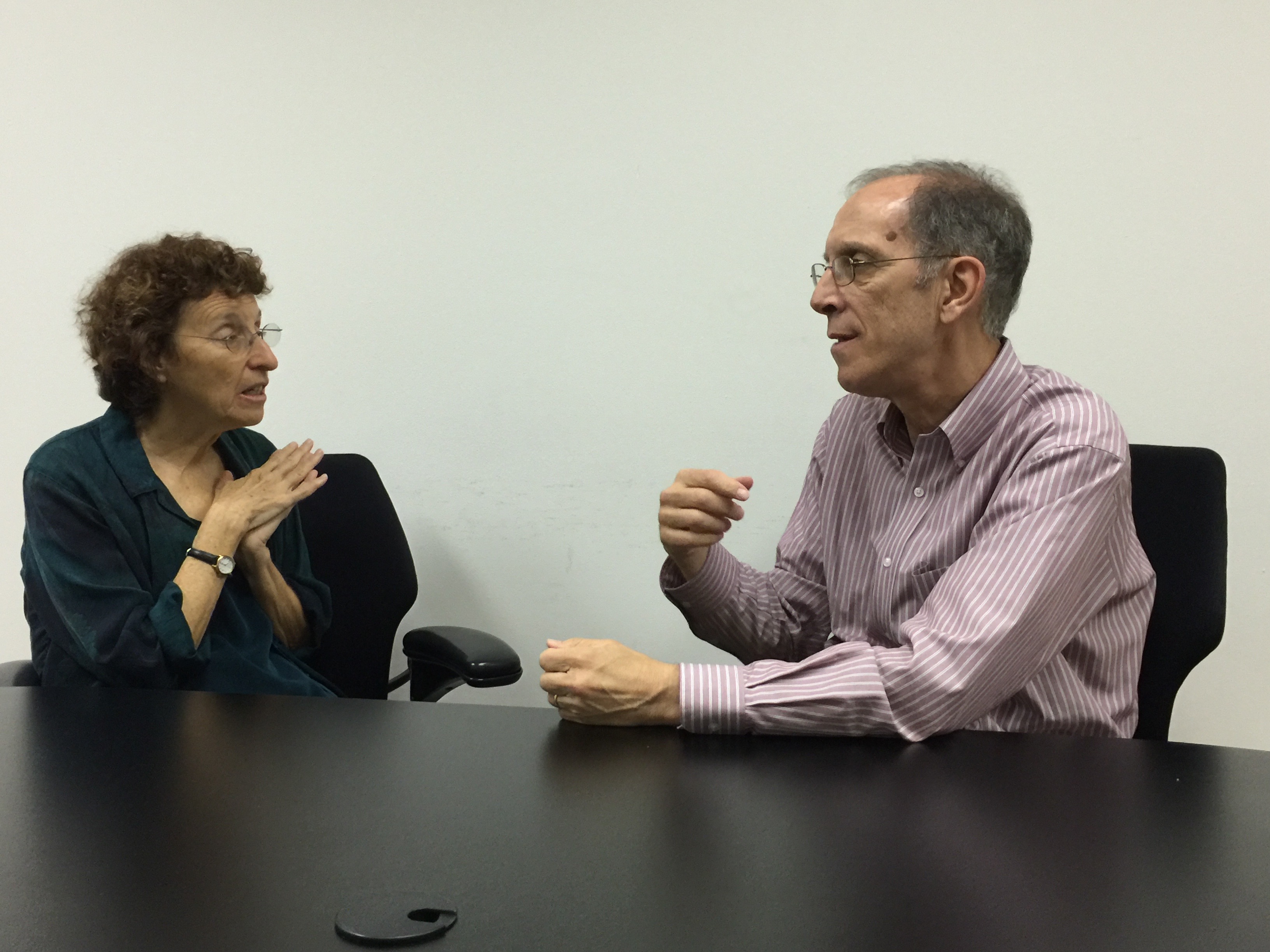 Ron and I were already champions of Dan Cohen’s world-changing Music & Memory program, which is featured in Connecting in the Land of Dementia, but we had never met Dan in person. The moment we learned we were going to New York City, we reached out to Dan and he agreed to meet with us.
Ron and I were already champions of Dan Cohen’s world-changing Music & Memory program, which is featured in Connecting in the Land of Dementia, but we had never met Dan in person. The moment we learned we were going to New York City, we reached out to Dan and he agreed to meet with us.
Dan is a prime example of one collaborative person making a difference for thousands. Eighteen states have already funded Music & Memory rollouts as a best practice approach for care facilities to improve quality of life for persons with dementia. In Toronto, everyone who is diagnosed with dementia receives a free iPod so they can enjoy personalized music. Dan and his team have trained 5000 dementia care managers, who understand how effective this program is. He is currently collaborating with hospitals, hospice, and prisons, as well as long term care communities.
Here is some of the wisdom he shared with us.
“We all need to create our personal play lists now,” Dan says. “Music makes any healthcare encounter better. Whether you’re waiting in the doctor’s office, going into the hospital, attending rehab, or moving into a care community, you’ll have a more comfortable experience when you are able to listen to favorite songs.”
Click here to listen to Dan Cohen.
Click here to learn more about the Music and Memory program.
Read more about Dan’s programs in Connecting in the Land of Dementia: Creative Activities to Explore Together. Order your copy from your favorite independent or online bookstore.
At Long Last: A Page-Turning Love Story
My hands trembled as I reached out my arms. For three long years I’d been working toward this meeting and yearning for this moment. Now, it was finally here. She was more beautiful than I had imagined, with a pleasing weight, just right for holding, just right for spending long hours with. From a glance, her personality seemed strong and purposeful and yet her warm, colorful exterior told me she would be easy to read. As she gradually opened up to me, I felt her power, her accessibility, her willingness to share ideas and wisdom. She felt great; she looked great; and she was brimming with exciting new ideas. Three long years and finally, she was in my arms. I hugged her tightly. At last I was holding my new book, Connecting in the Land of Dementia: Creative Activities to Explore Together
What makes this book unique? It’s the amazing people who contributed to it. During the writing process, I interviewed dozens of innovators across the globe, gathering ideas that engage the creative spirit so you can continue to experience meaningful moments throughout the dementia journey. These luminaries inspired me every step of the way and I am eager to share their ideas with you.
This book is brimming with easy projects using music, art, movies, cooking, gardening, and more. Here are some of the benefits you can look forward to when you do these activities together: Increased energy and socialization, an improved sense of purpose, reduced anxiety, and chances to express yourselves in new and meaningful ways.
Here’s even more good news about the ideas in this book. They’re adaptable for all ages and abilities, and you don’t need to have any special talents. Simply incorporate them into your daily routine and you’ll enrich your time together.
Marc Wortmann, Executive Director, Alzheimer’s Disease International, called the book “A ‘must read’ for every care partner because it really helps you to look at things differently!”
If you’re in the Kansas City area, please join us for the book launch on Sunday afternoon, October 9th, at 1:30 for a reception in the Truman Forum at the Plaza Library. The free presentation will begin at 2:00 This lively program, filled with ideas, stories, and songs, features myself and my partner Ron Zoglin, musical luminaries Rod Fleeman and Cynthia Schroer, and guest speaker Michelle Niedens from the Heart of America Chapter, Alzheimer’s Association.
RSVP 816-701-3407
For those of you in the Washington DC area, please join us at the free Alzheimer’s Foundation of America Caregiver’s Conference on Thursday September 29. We’ll be presenting there, along with other experts in the field. Click here to register.
We recently heard from several readers, saying, “This book is going to help so many people. I’m recommending it to my friends and colleagues.”
That’s what this is all about: enriching people’s lives through meaningful engagement.
It’s a challenge, bringing a new book into the world and we welcome your ideas and help in spreading the word about the book and the event.
You can order a copy now from Rainy Day Books, our book-seller for the event, or online.
Here is some advanced praise:
“A thoughtful and positive guide to the very thing I find myself constantly advocating to doctors, caregivers, and family members—social stimulation and creative arts will limit the need for psychiatric medication and improve the quality of life for those with dementia more than anything else.” Doug Wornell, MD, Life Solutions Group for Geriatric and Neurological Psychiatry
“Buy this book, read it, highlight what inspires you. As you make notes and bend pages to personalize this guide, you are creating a family treasure.” Carol Bradley Burdock, Founder of Minding Our Elders
“Deborah Shouse provides a great public service by shining light on the numerous creative activities that can meaningfully engage the minds and spirits of persons living with dementia. From personalized music to storytelling, Shouse makes it easy for caregivers to understand the various options they have to help their loved ones navigate through their everyday lives.” Dan Cohen, MSW Founding Executive Director, MUSIC & MEMORYsm
An Art Lesson in Paris
An integral part of experiencing Paris is looking at art. Chantal Debreu, a psychotherapist, serves as a volunteer and board member of the city’s Action Culturelle Alzheimer. To properly discuss the fascinating programs Chantal and her colleagues designed in collaboration with Musée d’Orsay, Musée de Cluny, and the Château de Versailles, we met at a sidewalk café over croissants and coffee.
(Note to fellow writers: It is extremely difficult to enjoy a croissant while typing on an iPad. The flakes flutter festively about the keyboard.)
Art Speaks a Universal Language
“Art is a universal language and looking at art is a wonderful way to access the creative capacities of people living with dementia,” Chantal says. “Looking at and discussing art can also at least temporarily reduce issues such as agitation, depression, apathy, and aggression.”
To facilitate such cultural connections, Chantal and Cindy Barotte, founder of Action Culturelle Alzheimer, created a three-day training program for volunteers, complete with information about dementia, case studies, and role play. Cindy developed a structure for finding meaning in works of art for volunteers and museum educators. The program connects each beneficiary with a trained volunteer who is there for five gallery visits. During the art experience, the caregiver has much-needed respite time.
“The volunteer helps people living with dementia explore their own capacities by supporting them,” Chantal says.
 The structure encourages engagement and creative expression. To view the work of art, participants sit in a semi-circle, so they can see and hear each other. The semi-circle creates a sense of group belonging and also blocks out the public. The volunteers sit in back of their person. If the person with dementia feels shy about speaking out, they may turn and share with their volunteer. The volunteer reports the insight to the educator, who shares it with the group.
The structure encourages engagement and creative expression. To view the work of art, participants sit in a semi-circle, so they can see and hear each other. The semi-circle creates a sense of group belonging and also blocks out the public. The volunteers sit in back of their person. If the person with dementia feels shy about speaking out, they may turn and share with their volunteer. The volunteer reports the insight to the educator, who shares it with the group.
Art Breaks Ice and Inspires Ideas
The program inspires conversation and ideas. People living with dementia tend to notice the details, but they may not attach a meaning to them. Little by little, the facilitators talk through the elements of the painting, helping them associate and build meaning, so they understand the story of the painting. When they start to make associations, they talk about their experiences. They come away feeling like they are someone; they have ideas and memories to share.
“At the Centre Pompidou, we discussed Bleu, a giant Miro canvas,” says Chantal. “We talked about it for 15 minutes. Everyone was involved and actively engaged in investigating, wondering, and sharing.”
Art Travels with You
Want to bring the Paris art experience home? Here are some tips:
- Select a work of art to comfortably view together, either on-line, from a book, or at a local gallery.
- As you look, ask open-ended questions, such as, “Why is that woman staring?”
- Encourage conversation by continuing to ask engaging questions. If someone notices a bicycle, make an affirming comment about the bicycle and ask “What else do you see?”
“It’s not about telling,” Chantal says. “It’s about asking.”
For more on the international scene, dive into my book, Connecting in the Land of Dementia: Creative Activities to Explore Together. Pre-order your signed copy.
Three Benefits of Artistic Alchemy
Last week, I wrote about Julian West and his work with music and dementia. Hannah Zeilig, PhD, is an expert in culture, language, and dementia, who participated in and documented Julian’s program. When I interviewed Hannah, I was inspired by her perspective on arts and communications and wanted to share a few of her key ideas.
“The project showed us that you can converse in so many ways,” says Hannah. “The musicians and the dancer reminded us that we all can communicate without language.”
“One of the questions we’re asking in the UK is ‘How can the arts help with dementia? What can arts do that a game of dominoes cannot?’ ” Hannah says. “The arts help people become brave in how they connect with each other.”
The arts also transcend our dependence on achievement, identity, and memory.
“Being scared of dementia is the biggest barrier,” Hannah says. “In our language and our media, dementia is stigmatized and portrayed as catastrophic. One of the natural and common fears is summarized by this: ‘If I can’t remember where I live and my achievements, how do I know who I am?’
Julian’s work reminds us that we are all creative.
“People with dementia can be brimming with creativity and humor and able to make connections with each other,” Hannah says.
During one of Julian’s sessions, the musicians were playing and the dancer was cavorting around the circle. One resident, Alicia, walked right up, took the dancer’s hands and lead her in a waltz.
At the end of the dance, Alicia was glowing. She smiled and said, “We really just did something.”
And she was right.
….
Other gifts from this work in the arts:
- The residents communicated with more sounds and gestures.
- The staff saw the creative side of the residents.
- The creative atmosphere opened everyone up to alternate ways to connecting.
For more about Hannah and her work, visit:
Orchestrating a Musical Conversation
When Ron’s dad was living in a memory care unit, Ron and I talked with the residents and their families, learning about their favorite songs. We orchestrated a sing-along and had fun working with everyone and putting together a scrapbook of each resident’s special tunes. The combination of music and conversation created a sense of community for us all. Julian West, who we met on a recent trip to London, is creating community through engaging people in music and dance. We really love the way he weaves the two art forms together and wanted to share his easy and adaptable ideas with you.
Julian West had no idea what would happen at the care facility, but he trusted it would be something wonderful. An accomplished oboist and a teacher at the Royal Academy of Music, Julian assembled a violist, a composer, a dancer, and an artist to share energy and their art with people who are living with dementia.
“This was an experiment to see what could happen,” Julian says. “We worked completely improvisationally.”
Once a week, for eight weeks, the troupe came to the residential care home and created a living arts experience with residents and staff. They began by inviting everyone to choose a percussion instrument, such as rain sticks, bells, shakers, tambourine, etc.
“We had a musical conversation,” Julian says. “One person made a sound and another answered. We also chatted a lot. People commented on the music or expressed an emotion or impression.”
The musicians added their instruments and the staff and residents joined in, through percussion and voice. They made fascinating sounds, like an improv jazz singer might do. The dancer twirled around in the center of their circle. Her free movements gave the group a focal point and inspired others to explore various movements.
“I let go of preconceptions and tried to create an open atmosphere,” Julian says.
The artists’ openness helped the “conversation” grow and blossom.
One woman who was living with dementia held up a tambourine, keeping it still and gazing at it as though it were a beautiful and revered object.
Julian’s first thought was, “She doesn’t know it’s a musical instrument”.
“I let that thought go,” he says. “I saw how expressive she was. Her interaction with the tambourine was beautiful and profound and she allowed us all to see the instrument differently.”
Even if you don’t have your own musicians and dancers at home, you can still create this supportive and creative atmosphere.
- Share a few percussion instruments, put on some music you both like, and make some joyful noises. Experiment with bee-bop syllables to add a sense of freedom.
- After the song, talk about the experience, what you liked, what you felt, and any other impressions that came up.
- Consider inviting a “guest dancer,” someone who likes to move to music, or a child of a friend who’s taking dancing lessons. Go ahead and add your own moves.
- Invite friends and family to join you. You’ll have something to laugh, and sing, and talk about.
For more information about Julian’s work, visit: www.julianwest.co.uk

